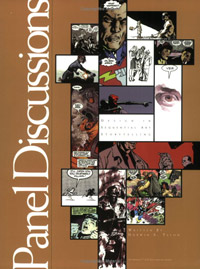By
Durwin S. Talon
 Talon takes us through 15 interviews of some of the
best artists in the comics tradition, examining their working process
and specifically how they design their panels. Like How to Read Superhero
Comics and Why, this book can only appeal to a small niche audience.
But the writing is pretty accessible, and browsing the book would appeal
to any artists and designers, not just comics fans. The book is worthwhile
for some of its specific examinations of pages and panels. The bulk of
the interviews, however, are quite redundant. Apparently most comics
artists use the same materials, structure their days similarly, and use
comparable processes – thumbnails, sketches, photocopies, then
loose pencils, tighter renderings, perhaps the computer. It’s only
when examining the minutia of their page layouts and drawings that we
see their vast design differences.
Talon takes us through 15 interviews of some of the
best artists in the comics tradition, examining their working process
and specifically how they design their panels. Like How to Read Superhero
Comics and Why, this book can only appeal to a small niche audience.
But the writing is pretty accessible, and browsing the book would appeal
to any artists and designers, not just comics fans. The book is worthwhile
for some of its specific examinations of pages and panels. The bulk of
the interviews, however, are quite redundant. Apparently most comics
artists use the same materials, structure their days similarly, and use
comparable processes – thumbnails, sketches, photocopies, then
loose pencils, tighter renderings, perhaps the computer. It’s only
when examining the minutia of their page layouts and drawings that we
see their vast design differences.
I purchased this book because it featured two of my favorite artists – Brian
Stelfreeze and Mike Mignola. Mignola’s section on using color to
evoke emotion and lead the eye was a highlight of the book. Likewise
with a particular page of Stelfreeze’s, a mind-bogglingly complex
nine-panel layout where every shadow shape subconsciously points the
eye to the next image.
I also enjoyed Walter Simonson’s and Mark Chiarello’s chapters,
and David Mazzuchelli’s showed his extreme thoughtfulness and intellectual
effort placed into every image. I did think the selection leaned too
heavily towards painters, with five of the fifteen, since they are a
new and small percentage of comics artists, and address different design
issues than standard inked fare. But the inclusion of classic comic geniuses
Dick Giordano and Will Eisner offset that concern. Not so with the bizarre
inclusion of Mike Carlin, who, while a competent editor, is not an artist
on par with the rest of the interviewees.
Talon’s underlying concept and organization ties the book together
well. Each chapter is split between the interview and a breakdown of
a particular page, emphasizing that artist’ particular design strength.
These strengths organize the chapters in the same order an artist moves
through the illustration process. So they cover concept, script, panel
grids, line dynamic, spotting blacks, eye movement through words and
acting, pacing, lettering, word balloon style, sound effects, digital
art, color, and bringing it all together.
This book would definitely be helpful for aspiring comics artists, as
well as interesting to artists who are interested in design and storytelling.
But it might bore the average comics fan, since the artists chosen are
not the flash-in-the-pan superstars of the moment but rather the industry’s
more traditional fine art illustrators. This is a shame, since fans who
breeze through their comics would get more appreciation from a deeper
understanding of the effort that goes into their creation. Above all,
the book showcases the amazing amount of thought, detail, storytelling,
and professional design that the best comics artists pour into every
panel of their work.